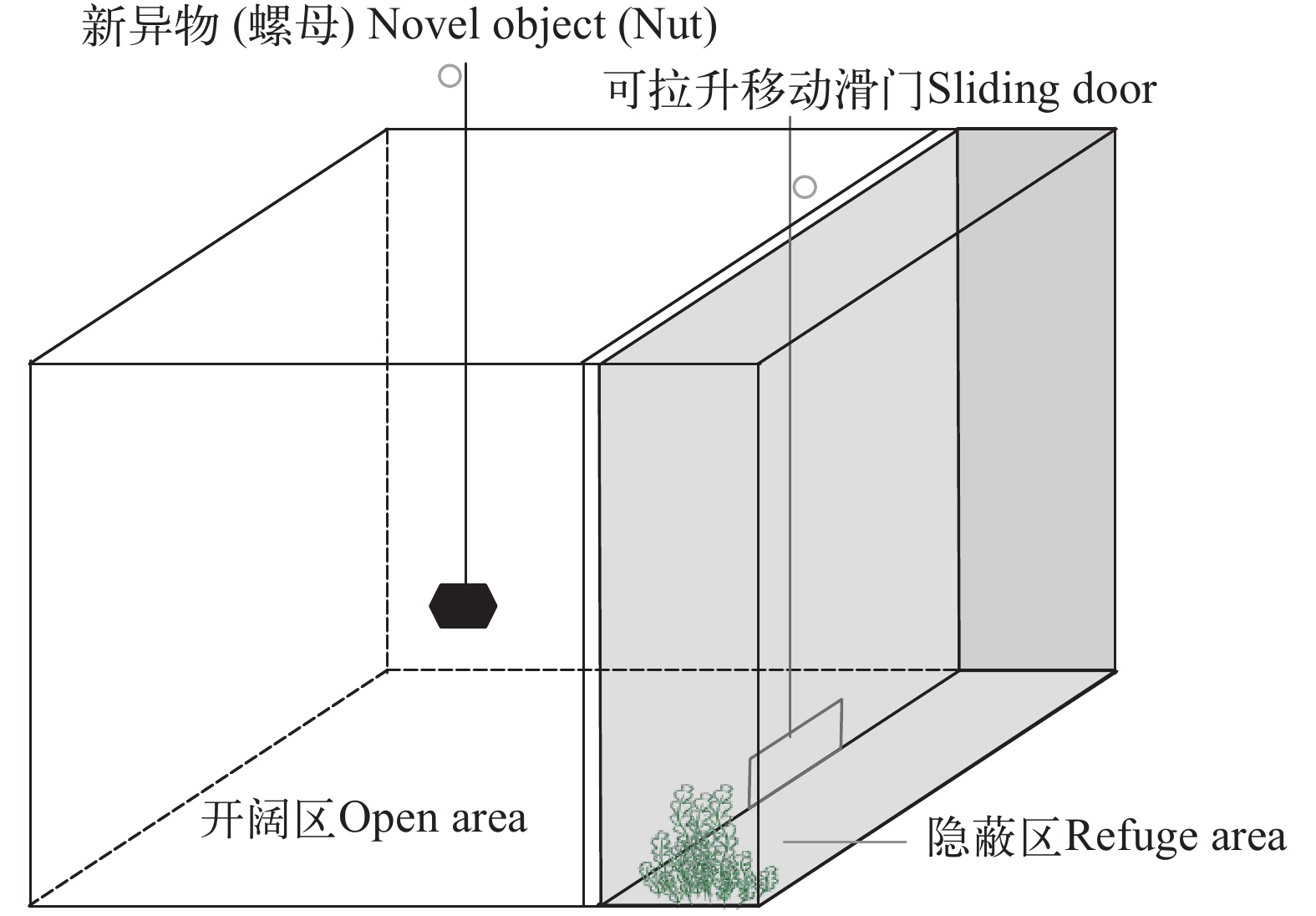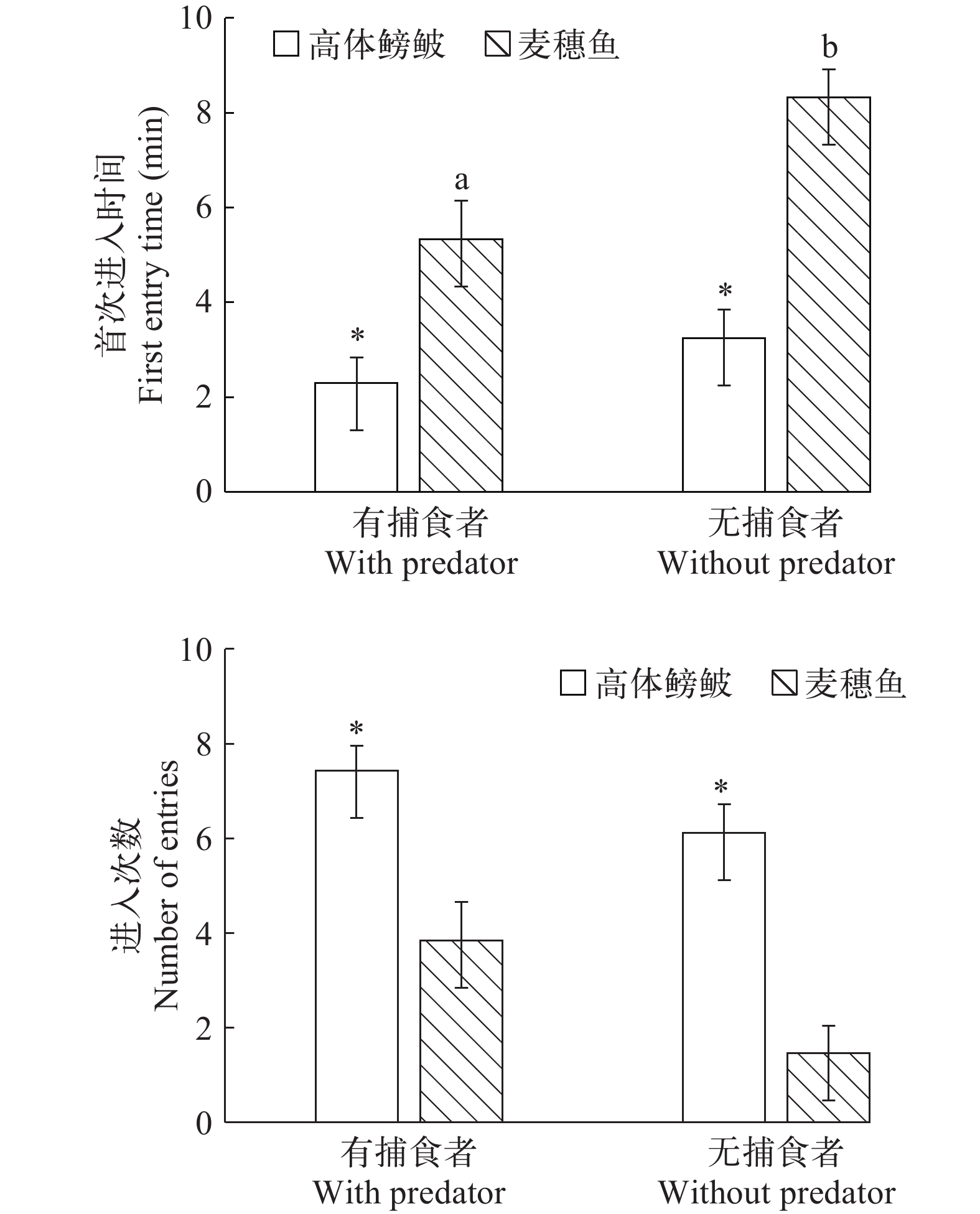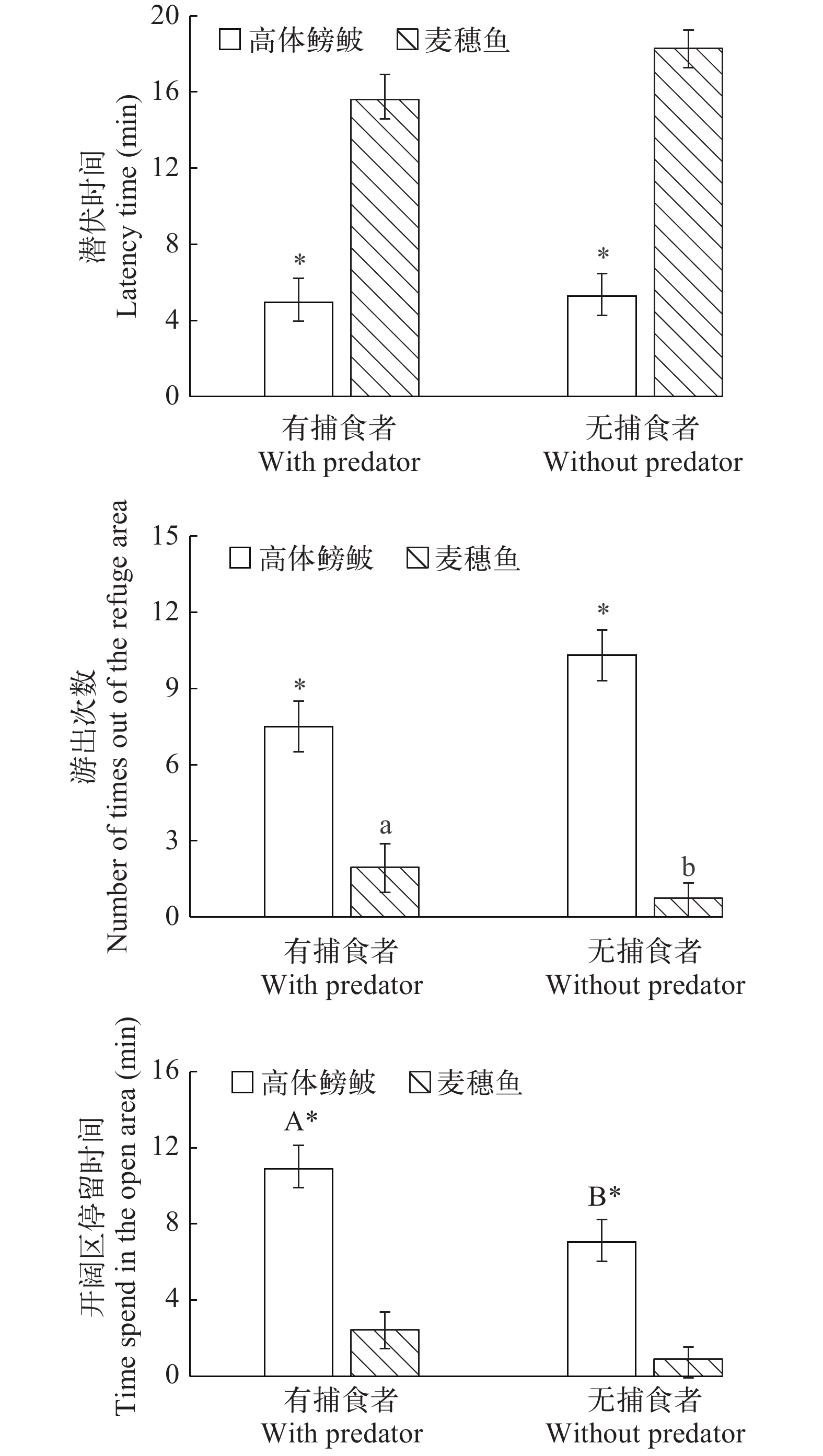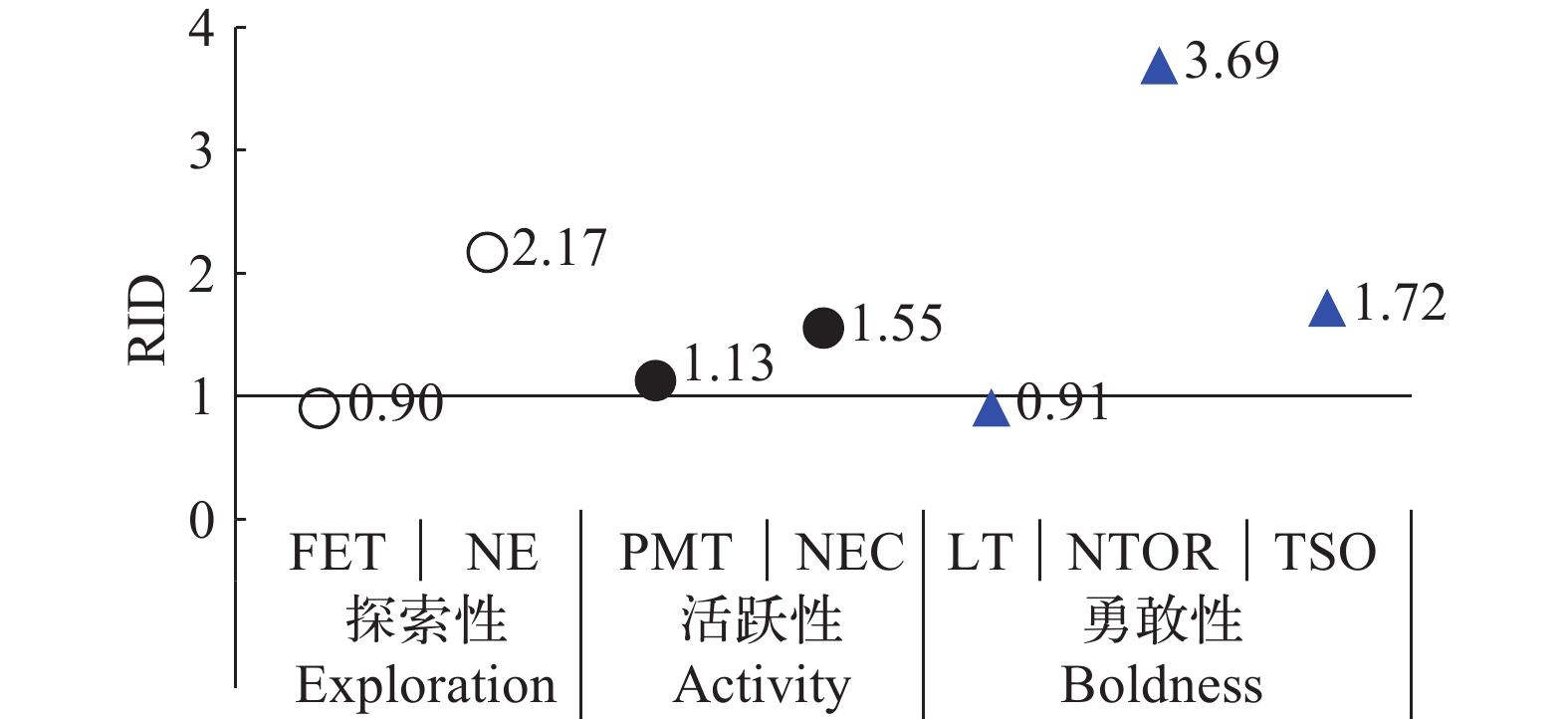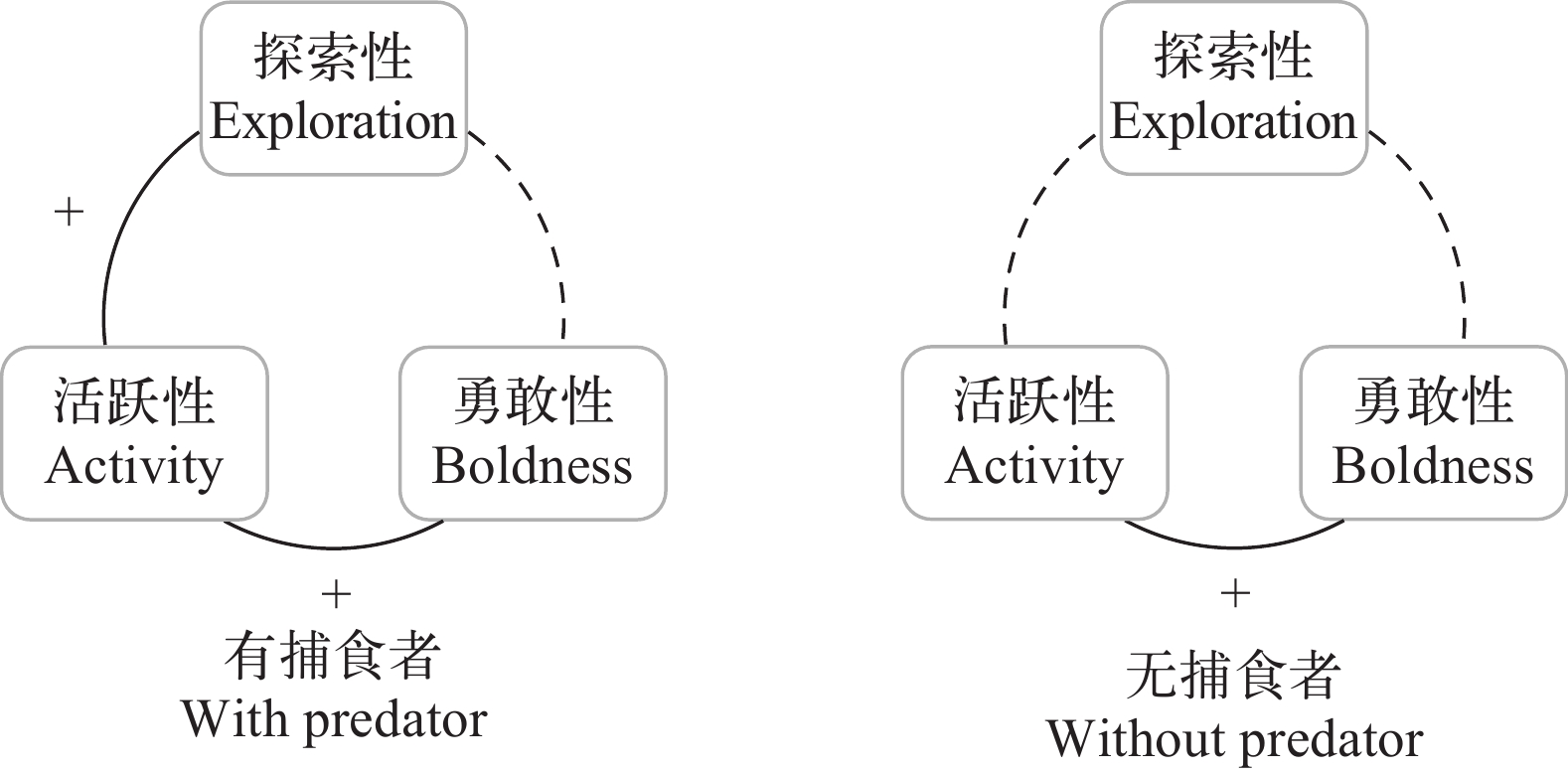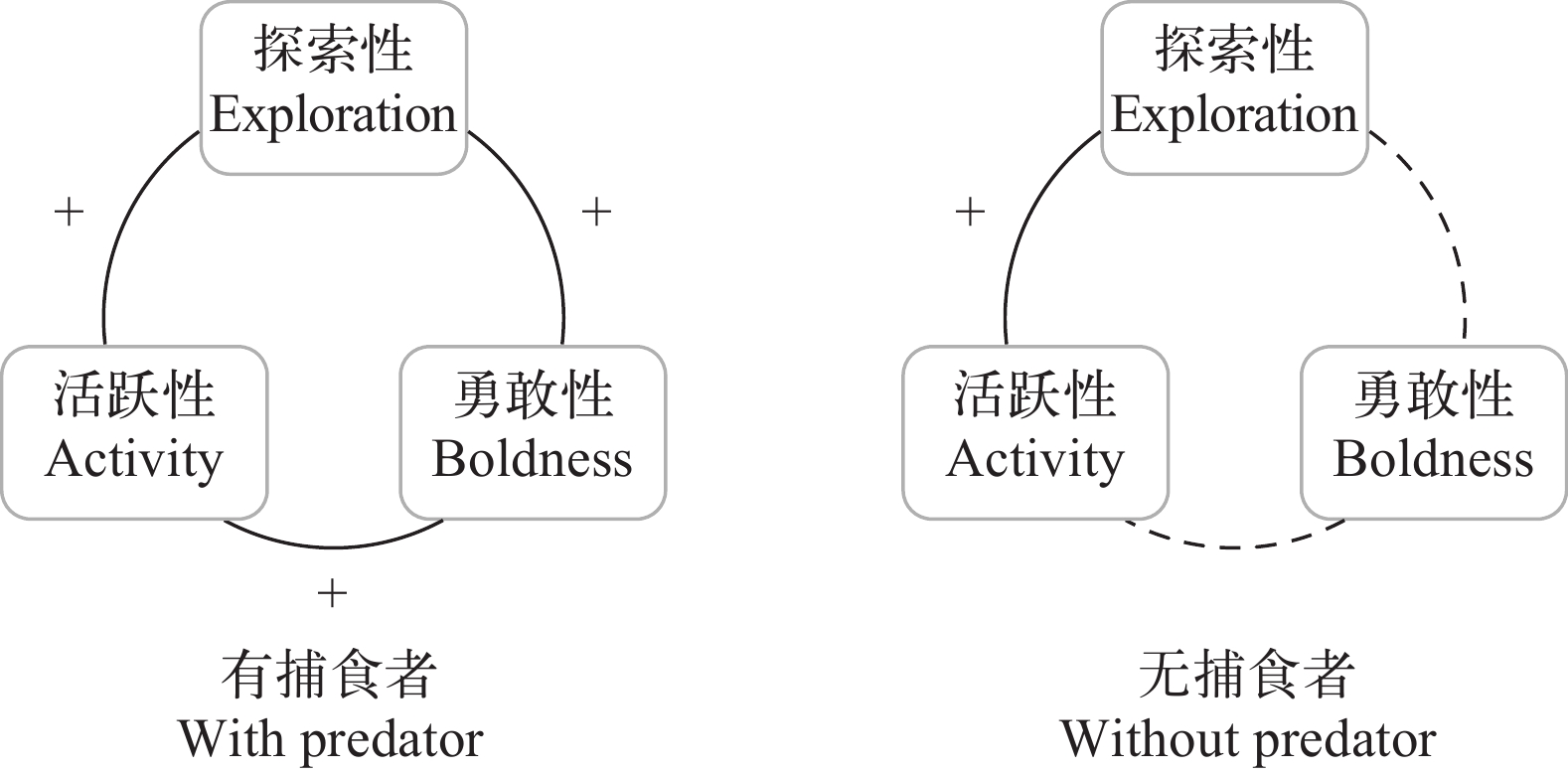INTERSPECIFIC DIFFERENCES IN THE PERSONALITIES OF TWO ECOLOGICALLY RELATED PREY FISH AND THE EFFECTS OF THEIR PREDATOR
-
摘要: 为探究不同猎物鱼个性的种间差异及其捕食者效应, 实验以乌鳢(Channa argus)为天然的捕食者, 选取自然界通常形成混合种群的高体鳑鲏(Rhodeus ocellatus)和麦穗鱼(Pseudorasbora parva)作为猎物鱼, 设置有捕食者和无捕食者处理组开展同质园实验; 之后, 分别测定了经历捕食环境处理的两种猎物鱼的探索性、活跃性和勇敢性3类个性特征, 分析两种猎物鱼个性特征的种间差异及其环境依赖性。结果发现: (1)高体鳑鲏和麦穗鱼个性存在显著的种间差异, 不管是否经历捕食者处理, 高体鳑鲏的探索性、活跃性和勇敢性均显著强于麦穗鱼(P<0.05); (2)捕食者处理导致高体鳑鲏和麦穗鱼探索性和勇敢性有增强的趋势, 但对二者的活跃性均无显著影响(P>0.05); (3)捕食者处理弱化了高体鳑鲏和麦穗鱼不同个性特征的种间差异, 强化了各自不同个性特征的偶联。结果提示: 两种猎物鱼个性特征的种间差异显著且均具有捕食者效应, 有捕食者环境下两种猎物鱼个性特征的种间差异变小, 表现出趋同化适应的趋势。Abstract: Personality refers to the persistent and consistent behavioral differences among individuals in a population under different spatio-temporal conditions. Predator-prey interactions are common in nature, and predation environment is the main driving force for the evolution of prey phenotypes (e.g. personalities). To investigate interspecific differences in the personalities of prey fish species and the effects of their predator, Channa argus was used as the predator, Rhodeus ocellatus and Pseudorasbora parva, which usually form mixed populations in nature, were used as the prey fish in this study. The prey fish were exposed to predator treatment or no predator treatment for one month, using the common garden experiment. Subsequently, the personalities, including exploration, activity and boldness of two prey fish species were measured, and the interspecific differences of different personalities and their environmental dependence were analyzed. The results showed that: (1) There were significant interspecific differences in personality between the two prey fish species. The exploration, activity and boldness of R. ocellatus were significantly stronger than those of the P. parva, regardless of whether they had undergone predator treatment or not (P<0.05). (2) Predator experience led to enhanced exploration and boldness of two prey fish species but had no significant effect on the activity of both (P>0.05). (3) Predator attenuated the interspecific differences of different personalities between two prey fish species and strengthened the coupling of their individual different personalities. The results suggested that the personalities of the prey fish have significant differences between species and both have a predator effect. Predator experience leads to the decrease of interspecific differences in the personalities of the two prey fish species, showing a trend of convergent adaptation.
-
动物个性指种群内的个体间跨时间和空间背景仍持续一致的行为差异, 通常包括探索性、活跃性、勇敢性、攻击性和社会性5类[1-4]。其中, 探索性(Exploration)指个体自发对新异环境(如新栖息地、新物体或新食物资源)进行的探索行为[1, 4]; 活跃性(Activity)指个体在无风险或非新颖的环境中的日常活动水平[1, 3]; 勇敢性(Boldness)指个体在面对已知的、具有一定危险性的环境, 或未知的、具有潜在风险和刺激的环境时所表现出的行为反应[1, 4, 5]; 攻击性(Aggressiveness)和社会性(Sociability)分别指群体中个体对其他个体的好斗反应以及回避或亲和行为反应[4]。不同个性之间协变、关联的行为特征的集合叫做行为集(Behavioral syndrome)[6-8]。个性反映了种群内动物表型的个体变异, 体现了物种生活史策略以及背后隐藏的有关其响应环境变化的适应进化潜能[6], 为理解动物行为的个体变异及其与种内生理多样性的关联提供了重要参考[8]。近年来, 动物个性特征及其在生态保护及人工驯养中的应用已成为行为生态学家研究的重点与热点之一。
捕食者-猎物相互作用普遍存在于自然界, 是构成生物群落的重要基础。有研究认为, 捕食者间接对猎物种群的影响甚至强于直接捕食所造成的致命性影响[9], 驱动猎物产生表型可塑性(即猎物根据捕食环境的不同影响而产生表型的适应性改变), 主要体现为猎物在形态、行为和生理上的反捕食响应[10]。在自然界, 由于人为活动和群落组分变动等因素, 猎物鱼遭遇的捕食胁迫程度不尽相同, 尤其是人工生态系统的构建与修复中捕食者去除或再引入, 导致环境(捕食)压力变动显著影响群落中猎物鱼生态位的交叠或重组。在不同时空格局下, 猎物行为表型如何响应捕食压力变动? 长期以来, 人们更多地关注某一物种的个性特征及其稳定性, 而对不同物种个性的种间差异关注较少, 尤其是不同捕食环境下处于相近生态位的猎物鱼个性的种间差异及其环境依赖性鲜见报道, 相关研究具有重要的生态学意义。
高体鳑鲏(Rhodeus ocellatus)隶属于鲤科、鳑鲏亚科、鳑鲏属, 麦穗鱼(Pseudorasbora parva)隶属于鲤科、亚科、麦穗鱼属, 二者均为淡水生态系统常见的杂食性小型鱼类。值得关注的是, 高体鳑鲏和麦穗鱼在各类池塘、河流和人工湿地等水域通常形成混合种群, 生态位重叠较大, 在自然生境下遭遇的捕食风险胁迫较为相似, 是探究不同物种个性种间差异及其捕食者效应的理想研究对象。本文探究了不同捕食环境下高体鳑鲏和麦穗鱼个性的种间差异, 并提出科学假设: 高体鳑鲏和麦穗鱼的个性存在种间差异, 但这种种间差异存在环境依赖性; 环境(捕食)压力可导致两种猎物鱼个性的种内种间差异变小(个性趋同)并强化种内不同个性特征的偶联。本研究旨在考察鱼类个性的种间差异及其环境依赖性(表型可塑性), 并为理解环境变迁下鱼类的生态适应性及其种内种间关系动态提供参考。
1. 材料与方法
1.1 实验动物
捕食者乌鳢(Channa argus)、猎物鱼高体鳑鲏(Rhodeus ocellatus)和麦穗鱼(Pseudorasbora parva)均采集自重庆师范大学三春湖(该水域生态系统已稳定存在15年以上, 水域面积近5.0×104 m2)。将高体鳑鲏和麦穗鱼暂养于重庆师范大学进化生理与行为学实验室野外研究基地大小相同的仿生态水泥池中(5.5 m×4.3 m×1.3 m, 实际水深为0.7 m), 分别给予有捕食者和无捕食者(去捕食化)处理。其中, 有捕食者处理组放置有2条乌鳢作为捕食者(规格分别为体重208.7 g、体长27.9 cm和体重240.4 g、体长31.2 cm)。水泥池内的环境模拟捕食者和猎物鱼自然生境(池内水体抽取自天然水体, 水体深度和透明度与自然水体相近), 池内放置背角无齿蚌(Anodonta woodiana)40余个, 采用自然水温和光照。1个月后, 分别选取经历不同捕食环境处理组的高体鳑鲏和麦穗鱼进行实验测定(为尽可能减少两种猎物鱼体型体色差异带来的影响, 本研究仅以两种猎物鱼雌鱼为对象开展研究)。测定前将实验鱼禁食24h, 两种猎物鱼的形态参数见表 1。
表 1 两种猎物鱼的形态参数Table 1. Morphological parameters of two prey fish species (n=26)猎物鱼
Prey fish处理
Treatment体重
Body mass (g)体长
Body length (cm)肥满度
Condition factor
(100 g/cm3)高体鳑鲏
Rhodeus ocellatus有捕食者 1.65±0.047* 4.27±0.036 2.12±0.033 无捕食者 1.81±0.042 4.42±0.037 2.11±0.055 麦穗鱼
Pseudoras-
bora parva有捕食者 2.02±0.050* 5.20±0.042 1.43±0.027 无捕食者 2.32±0.072 5.29±0.052 1.56±0.025 注: 肥满度=100×体重/体长3数据以平均值±标准误表示; *表示有无捕食者处理下同种猎物鱼的某一形态参数差异显著Note: Condition factor=100×mass (g)/length (cm)3. Data are presented as mean±SE. An asterisk (*) indicates that predator treatment has a significant difference in a certain morphological parameter of the same prey fish 1.2 实验设计
采用同质园实验(Common garden experiment)探究捕食环境经历(有捕食者和无捕食者处理)对两种猎物鱼(高体鳑鲏和麦穗鱼)形态和不同个性特征的影响及其种间差异。由于动物5类不同个性特征的生态学意义及其检测所需要的实验装置差异较大, 通常研究中往往只对其中的2—3类个性特征开展研究, 本研究仅测定两种猎物鱼的探索性、活跃性和勇敢性。所有实验处理及参数测定均在户外基地进行, 行为学测定时无捕食者, 所有经过不同处理的实验鱼的测试环境一致。每个处理组个性特征的测试样本量均为n=26。在实验测定期间, 天气晴朗、气候条件一致, 为消除昼夜差异对猎物鱼个性的影响, 所有实验测定时间均为09:00—18:00。在不同环境下两种猎物鱼个性的种间差异程度以各自环境下的种间差异的比值RID表示, RID越接近1种间差异越小, RID等于1说明不同环境下的种间差异无变化。
1.3 实验方法
采用自制的鱼类行为学装置(图 1和图 2)开展个性测定。装置(图 1)包括实验水泥池(1.7 m×1.5 m×1 m, 池内水体为2000 L)、个性测定系统、电脑及连接的摄像头(Logitech Webcam Pro 920)。个性测定系统(图 2)固定并悬置于实验水泥池中心, 该系统主体为不锈钢网(45 cm×30 cm×50 cm, 测试时网底距离水面30 cm), 内部用一个不透明挡板分成两隔间, 即开阔区(Open area: 35 cm×30 cm×50 cm)和隐蔽区(Refuge area: 10 cm×30 cm×50 cm)。开阔区是开放的, 为相对风险区; 隐蔽区为相对安全区, 内有为3颗呈“品”字形排列的人造水草(高10 cm)。挡板底部中心处有一可拉升上下滑动的小门(8 cm×5 cm)连通开阔区和隐蔽区。个性测定系统四周(含不透明挡板和小门)贴有灰色广告纸, 开阔区底部不做处理, 保证内外水体交换。测定时在水泥池上方架构一层不透明防水塑料板, 使测定装置内的光照强度与猎物鱼生活的自然水体相近, 同时可避免水面反射对视频录制效果的影响; 隐蔽区顶部加有不透明防水塑料板以提供内部黑暗环境。不同个性特征的测定顺序依次为探索性-活跃性-勇敢性。测定期间水温为(30±1)℃。
探索性测定 随机选取单尾猎物鱼放入开阔区(测试探索性只用到开阔区, 期间关闭小门)适应15min。在适应结束后, 缓缓沉入新异物物体六角螺母(内径1 cm, 外径1.5 cm)至水体中心(螺母中心距离水面15 cm), 录制视频10min。以螺母为中心, 将其周边距离5 cm (两种猎物鱼的平均体长)范围内的区域定义为新异物区。猎物鱼的探索性以其首次进入(身体全部进入)时间新异物区的时间(若在观测的10min内猎物鱼一直未进入新异物区, 则该参数计为10min)、进入新异物区次数表征。
活跃性测定 探索性测定完成后, 缓缓提起螺母, 给予猎物鱼10min的恢复期。在恢复适应结束后, 录制视频10min。猎物鱼的活跃性以其运动时间比(运动时间占观测时间的比例)、运动方格数(后期分析视频时, 将开阔区底部均分成20个7.5 cm×7 cm的小方格并计算数出猎物鱼游过的方格数)表征。
勇敢性测定 在活跃性测定完成后, 提起可拉升移动滑动露出矩形开口, 用渔网将猎物鱼赶入隐蔽区并关闭小门, 给予15min的适应期以使其充分熟悉隐蔽区环境。在适应结束后, 轻轻提起小门并录制视频20min。猎物鱼的勇敢性以其潜伏时间(即首次游出隐蔽区的时间, 若在观测的20min内猎物鱼一直未游出隐蔽区, 则该参数计为20min)、游出次数、开阔区停留时间表征。
1.4 数据处理
采用SPSS软件(SPSS 19.0 Inc., USA)对数据进行统计分析。首先检验数据是否服从正态分布及方差齐性。采用独立样本t检验检测捕食者处理对猎物鱼形态参数的影响。由于捕食者处理对猎物鱼体重有显著影响, 以物种和捕食者处理为固定变量、以体重为协变量, 采用一般线性模型(General linear model)分析不同组间的个性特征的差异。物种不同个性特征之间的关联采用Spearman相关分析。数据均以平均值±标准误(mean±SE)表示, 显著性水平设为P<0.05。
2. 结果
2.1 物种和捕食者对个性的影响
物种对猎物鱼的所有个性参数均影响显著, 高体鳑鲏和麦穗鱼个性存在显著的种间差异(P<0.05; 表 2), 不管是否经历捕食者处理, 高体鳑鲏的探索性、活跃性和勇敢性均显著强于麦穗鱼(P<0.05; 图 3—5)。
表 2 物种和捕食者对猎物鱼个性的影响Table 2. Effects of species and predator on the personalities of prey fish项目 Item 探索性 Exploration 活跃性 Activity 勇敢性Boldness 首次进入时间 进入次数 运动时间比 运动方格数 潜伏时间 游出次数 开阔区停留时间 物种
SpeciesF=18.82
P<0.001*F=15.93
P<0.001*F=41.86
P<0.001*F=38.77
P<0.001*F=52.33
P<0.001*F=53.69
P<0.001*F=36.89
P<0.001*捕食者
PredatorF=9.574
P=0.003*F=3.383
P=0.069F=2.036
P=0.157F=0.793
P=0.375F=2.615
P=0.109F=0.396
P=0.531F=5.040
P=0.027*体重
Body massF=0.008
P=0.928F=0.002
P=0.962F=0.163
P=0.687F=0.160
P=0.690F=0.282
P=0.597F=2.115
P=0.149F=0.109
P=0.742物种×捕食者
Species × PredatorF=1.409
P=0.238F=1.952
P=0.166F=0.116
P=0.734F=3.457
P=0.066F=0.166
P=0.685F=5.347
P=0.023*F=0.142
P=0.707注: * P<0.05差异显著; 下同Note: * P<0.05 indicates significant difference. The same applies below ![]() 图 3 捕食者对两种猎物鱼探索性的影响a, b上标字母不同表示捕食者处理对麦穗鱼探索性指标的影响显著(P<0.05); *表示有或无捕食者处理下两种猎物鱼探索性指标存在显著种间差异(P<0.05)Figure 3. Effects of predator on the exploration of two prey fish speciesa, b. Different letters indicate that predator has a significant influence on the exploration Pseudorasbora parva (P<0.05); *indicates significant differences in exploration between species with or without predator (P<0.05)
图 3 捕食者对两种猎物鱼探索性的影响a, b上标字母不同表示捕食者处理对麦穗鱼探索性指标的影响显著(P<0.05); *表示有或无捕食者处理下两种猎物鱼探索性指标存在显著种间差异(P<0.05)Figure 3. Effects of predator on the exploration of two prey fish speciesa, b. Different letters indicate that predator has a significant influence on the exploration Pseudorasbora parva (P<0.05); *indicates significant differences in exploration between species with or without predator (P<0.05)![]() 图 5 捕食者对两种猎物鱼勇敢性的影响A, B和a, b上标字母不同分别表示捕食者处理对高体鳑鲏和麦穗鱼勇敢性指标的影响显著(P<0.05); *表示有或无捕食者处理下两种猎物鱼勇敢性指标存在显著种间差异(P<0.05)Figure 5. Effects of predator on the boldness of two prey fish speciesA, B and a, b: Different uppercase letters and lowercase letters indicate that predator has a significant influence on the boldness of Rhodeus ocellatus and Pseudorasbora parva, respectively (P<0.05); * indicates significant differences in boldness between species with or without predator (P<0.05)
图 5 捕食者对两种猎物鱼勇敢性的影响A, B和a, b上标字母不同分别表示捕食者处理对高体鳑鲏和麦穗鱼勇敢性指标的影响显著(P<0.05); *表示有或无捕食者处理下两种猎物鱼勇敢性指标存在显著种间差异(P<0.05)Figure 5. Effects of predator on the boldness of two prey fish speciesA, B and a, b: Different uppercase letters and lowercase letters indicate that predator has a significant influence on the boldness of Rhodeus ocellatus and Pseudorasbora parva, respectively (P<0.05); * indicates significant differences in boldness between species with or without predator (P<0.05)捕食者对猎物鱼探索性(首次进入时间)和勇敢性(开阔区停留时间)影响显著(P<0.05), 捕食者处理导致高体鳑鲏和麦穗鱼探索性和勇敢性有增强的趋势(图 3、图 5), 但对二者的活跃性无显著影响(P>0.05; 图 4)。
物种和捕食者处理猎物鱼勇敢性(游出次数)的影响具有交互作用(P<0.05; 表 2)。
2.2 捕食者对猎物鱼个性种内种间差异的影响
捕食者处理对高体鳑鲏不同个性特征种内变异的影响较小, 有或无捕食者处理下高体鳑鲏不同个性参数的变异系数较为相近(表 3)。捕食者处理对麦穗鱼个性特征种内变异有较大影响, 捕食者处理导致其进入新异物区次数、游出隐蔽区次数和开阔区停留时间等参数的变异系数减小(表 3)。
表 3 捕食者对两种猎物鱼个性种内变异(变异系数)的影响Table 3. Effects of predator on intraspecific variation (cv) in personalities of two prey fishes猎物鱼
Prey fish处理
Treatment探索性Exploration 活跃性Activity 勇敢性Boldness 首次进入时间 进入次数 运动时间比 运动方格数 潜伏时间 游出次数 开阔区停留时间 高体鳑鲏
Rhodeus ocellatus有捕食者 1.184 1.062 0.233 0.529 1.295 0.991 0.572 无捕食者 0.941 0.861 0.155 0.467 1.149 0.849 0.858 麦穗鱼
Pseudorasbora parva有捕食者 0.775 1.217 0.762 1.001 0.429 1.957 1.899 无捕食者 0.354 2.207 0.847 0.967 0.270 3.026 3.369 捕食者处理导致高体鳑鲏和麦穗鱼个性特征的种间差异(高体鳑鲏/麦穗鱼)减小, 无捕食者和有捕食者下两种猎物鱼进入新异物区次数、运动方格数、游出隐蔽区次数和开阔区停留时间等参数的比值RID显著大于1 (图 6)。
![]() 图 6 捕食者对两种猎物鱼个性种间差异(高体鳑鲏/麦穗鱼)比例的影响RID. 无捕食者/有捕食者处理下个性的种间差异比; FET. 首次进入时间; NE. 进入次数; PMT. 运动时间比; NGC. 运动方格数; LT. 潜伏时间; NTOR. 游出次数; TSO. 开阔区停留时间
图 6 捕食者对两种猎物鱼个性种间差异(高体鳑鲏/麦穗鱼)比例的影响RID. 无捕食者/有捕食者处理下个性的种间差异比; FET. 首次进入时间; NE. 进入次数; PMT. 运动时间比; NGC. 运动方格数; LT. 潜伏时间; NTOR. 游出次数; TSO. 开阔区停留时间$\mathrm{R}\mathrm{I}\mathrm{D}=\frac{\mathrm{无}\mathrm{捕}\mathrm{食}\mathrm{者}\mathrm{处}\mathrm{理}\mathrm{下}\mathrm{高}\mathrm{体}\mathrm{鳑}\mathrm{鲏}\mathrm{个}\mathrm{性}\mathrm{参}\mathrm{数}/\mathrm{麦}\mathrm{穗}\mathrm{鱼}\mathrm{个}\mathrm{性}\mathrm{参}\mathrm{数}}{\mathrm{有}\mathrm{捕}\mathrm{食}\mathrm{者}\mathrm{处}\mathrm{理}\mathrm{下}\mathrm{高}\mathrm{体}\mathrm{鳑}\mathrm{鲏}\mathrm{个}\mathrm{性}\mathrm{参}\mathrm{数}/\mathrm{麦}\mathrm{穗}\mathrm{鱼}\mathrm{个}\mathrm{性}\mathrm{参}\mathrm{数}}$ Figure 6. Effect of predator on the ratio of interspecies differences in the personalities of two prey fish species (Rhodeus ocellatus/Pseudorasbora parva)RID. Ratio of interspecific differences in the personalities without and with predator; FET. First entry time; NE: Number of entries; PMT. Percentage of mobile time; NGC. Number of grids crossed; LT. Latency time; NTOR. Number of times out of the refuge area; TSO. Time spend in the open area${\rm{RID}}=\frac{\mathrm{t}\mathrm{h}\mathrm{e}\mathrm{ }\mathrm{r}\mathrm{a}\mathrm{t}\mathrm{i}\mathrm{o}\mathrm{ }\mathrm{o}\mathrm{f}\mathrm{ }\mathrm{ }\mathrm{p}\mathrm{e}\mathrm{r}\mathrm{s}\mathrm{o}\mathrm{n}\mathrm{a}\mathrm{l}\mathrm{i}\mathrm{t}\mathrm{y}\mathrm{ }\mathrm{p}\mathrm{a}\mathrm{r}\mathrm{a}\mathrm{m}\mathrm{e}\mathrm{t}\mathrm{e}\mathrm{r}\mathrm{ }\mathrm{o}\mathrm{f}\mathrm{ }\mathrm{t}\mathrm{w}\mathrm{o}\mathrm{ }\mathrm{p}\mathrm{r}\mathrm{e}\mathrm{y}\mathrm{ }\mathrm{f}\mathrm{i}\mathrm{s}\mathrm{h}\mathrm{ }\mathrm{w}\mathrm{i}\mathrm{t}\mathrm{h}\mathrm{o}\mathrm{u}\mathrm{t}\mathrm{ }\mathrm{p}\mathrm{r}\mathrm{e}\mathrm{d}\mathrm{a}\mathrm{t}\mathrm{o}\mathrm{r}\mathrm{ }\mathrm{t}\mathrm{r}\mathrm{e}\mathrm{a}\mathrm{t}\mathrm{m}\mathrm{e}\mathrm{n}\mathrm{t}}{\mathrm{t}\mathrm{h}\mathrm{e}\mathrm{ }\mathrm{r}\mathrm{a}\mathrm{t}\mathrm{i}\mathrm{o}\mathrm{ }\mathrm{o}\mathrm{f}\mathrm{ }\mathrm{ }\mathrm{ }\mathrm{p}\mathrm{e}\mathrm{r}\mathrm{s}\mathrm{o}\mathrm{n}\mathrm{a}\mathrm{l}\mathrm{i}\mathrm{t}\mathrm{y}\mathrm{ }\mathrm{p}\mathrm{a}\mathrm{r}\mathrm{a}\mathrm{m}\mathrm{e}\mathrm{t}\mathrm{e}\mathrm{r}\mathrm{ }\mathrm{o}\mathrm{f}\mathrm{ }\mathrm{t}\mathrm{w}\mathrm{o}\mathrm{ }\mathrm{p}\mathrm{r}\mathrm{e}\mathrm{y}\mathrm{ }\mathrm{f}\mathrm{i}\mathrm{s}\mathrm{h}\mathrm{ }\mathrm{w}\mathrm{i}\mathrm{t}\mathrm{h}\mathrm{ }\mathrm{p}\mathrm{r}\mathrm{e}\mathrm{d}\mathrm{a}\mathrm{t}\mathrm{o}\mathrm{r}\mathrm{ }\mathrm{t}\mathrm{r}\mathrm{e}\mathrm{a}\mathrm{t}\mathrm{m}\mathrm{e}\mathrm{n}\mathrm{t}}$ 2.3 捕食者对猎物鱼不同个性特征关联的影响
捕食者处理强化了猎物鱼各自不同个性特征的偶联。在有捕食者处理下, 高体鳑鲏探索性与活跃性、活跃性与勇敢性显著正相关(P<0.05; 表 4), 麦穗鱼探索性、活跃性与勇敢性之间均呈两两显著正相关(P<0.05; 表 5)。在无捕食者处理下, 高体鳑鲏仅有活跃性与勇敢性正相关(P<0.05), 麦穗鱼仅有活跃性与探索性正相关(P<0.05; 表 4、表 5)。
表 4 高体鳑鲏探索性、活跃性和勇敢性之间的关联Table 4. The relationships between exploration, activity and boldness in Rhodeus ocellatus活跃性 Activity 勇敢性 Boldness 运动时间比 运动方格数 潜伏时间 游出次数 开阔区停留时间 有捕食者
With
predator
探索性 首次进入时间 r=–0.540, P=0.004* r=–0.164, P=0.423 r=–0.201, P=0.324 r=0.009, P=0.965 r=0.169, P=0.410 进入次数 r=0.082, P=0.689 r=0.264, P=0.192 r=0.315, P=0.117 r=0.106, P=0.606 r=–0.366, P=0.066 活跃性 运动时间比 r=–0.272, P=0.179 r=0.418, P=0.034* r=0.056, P=0.785 运动方格数 r=–0.170, P=0.407 r=0.405, P=0.040* r=0.149, P=0.468 无捕食者
Without
predator
探索性 首次进入时间 r=–0.199, P=0.330 r=–0.015, P=0.944 r=–0.043, P=0.833 r=0.171, P=0.402 r=0.100, P=0.627 进入次数 r=0.035, P=0.867 r=0.083, P=0.685 r=0.191, P=0.350 r=–0.194, P=0.343 r=–0.307, P=0.127 活跃性 运动时间比 r=–0.276, P=0.172 r=0.491, P=0.011* r=0.465, P=0.017* 运动方格数 r=–0.146, P=0.477 r=0.348, P=0.082 r=0.346, P=0.083 表 5 麦穗鱼探索性、活跃性和勇敢性之间的关联Table 5. The relationships between exploration, activity and boldness in Pseudorasbora parva活跃性Activity 勇敢性Boldness 运动时间比 运动方格数 潜伏时间 游出次数 开阔区停留时间 有捕食者
With
predator探索性 首次进入时间 r=–0.727, P<0.001* r=–0.779, P<0.001* r=0.389, P=0.050 r=–0.435, P=0.026* r=–0.377, P=0.057 进入次数 r=0.683, P<0.001* r=0.703, P<0.001* r=–0.249, P=0.221 r=0.284, P=0.159 r=0.211, P=0.301 活跃性 运动时间比 r=–0.368, P=0.065 r=0.426, P=0.030* r=0.347, P=0.083 运动方格数 r=–0.473, P=0.015* r=0.525, P=0.006* r=0.454, P=0.020* 无捕食者
Without
predator探索性 首次进入时间 r=–0.682, P<0.001* r=–0.657, P<0.001* r=–0.072, P=0.727 r=0.072, P=0.727 r=0.072, P=0.727 进入次数 r=0.671, P<0.001* r=0.647, P<0.001* r=0.052, P=0.802 r=–0.052, P=0.802 r=–0.052, P=0.802 活跃性 运动时间比 r=–0.084, P=0.682 r=0.084, P=0.682 r=0.066, P=0.749 运动方格数 r=–0.165, P=0.420 r=0.165, P=0.420 r=0.144, P=0.483 3. 讨论
动物行为表现的生态收益和代价依环境背景的差异而不同。猎物鱼遭遇捕食者时出于防御本能而做出多样化的反捕食响应, 这些行为的改变可能会导致觅食和生长受到限制, 从而影响长期的生存[11, 12]。适当提高探索性、活跃性和勇敢性等个性表现, 可能因获取更多食物资源而利于生长、竞争及种群栖息地拓展, 但也可能增加其能量消耗及暴露于捕食者视野或其他风险环境的概率从而造成生存威胁[13, 14], 因此动物个性及其环境依赖性体现了其环境适应策略, 与其生存适合度密切相关。研究表明, 当捕食风险增加时, 猎物鱼的行为表达更为活跃。例如, 与乌鳢混养25d后的中华倒刺鲃(Spinibarbus sinensis)幼鱼表现出更高的探索性和活跃性[15]。与探索性不同, 勇敢性降低可减少偶遇捕食者的概率, 在一定程度上降低被捕食风险[15, 16], 但这种行为的改变又将对动物社群等级的维持以及觅食求偶等带来不利的生态影响。值得关注的是, 不同物种对捕食者的行为响应不尽相同, 可能存在种间差异[14]。例如, 与乌鳢混养后的中华倒刺鲃幼鱼表现出更高的活跃性[15], 而与南方鲇(Silurus meridionalis)混养20d后的鳊(Parabramis pekinensis)幼鱼的活跃性却无显著变化[17]。有研究发现, 有被捕食经历的蓝鳃太阳鱼(Lepomis macrochirus)与无被捕食经历的个体相比, 表现出更高的勇敢性[18]; 然而也有研究发现, 来自高捕食压力种群的宽鳍鱲(Zacco platypus)与低捕食压力种群相比, 首次游出隐蔽区的潜伏时间等勇敢性参数无显著差异[12]; 另有研究发现, 南方鲇对鳊幼鱼的勇敢性无显著影响[17]。在本研究中, 高体鳑鲏和麦穗鱼的个性存在显著种间差异, 不管是否经历捕食者处理, 高体鳑鲏的探索性、活跃性和勇敢性均显著强于麦穗鱼; 捕食者处理导致两种猎物鱼探索性和勇敢性有增强的趋势, 但对活跃性无显著影响, 提示尽管两种猎物鱼的行为范式相异, 但其应对捕食者效应的行为策略可能相似, 推测其可能是通过增加探索性和勇敢性以提升对捕食风险的侦查效率。此外, 物种和捕食者处理交互作用对猎物鱼勇敢性(游出次数)等参数的影响显著, 捕食者处理有导致高体鳑鲏和麦穗鱼种内种间差异变小的趋势, 特别是无捕食者和有捕食者下两种猎物鱼进入新异物区次数、运动方格数、游出隐蔽区次数和开阔区停留时间等参数的比值显著大于1, 提示高体鳑鲏和麦穗鱼应对环境捕食压力表现出了趋同化适应的趋势, 研究结果支持本文提出的科学假设。
行为集的表达可能是动物多种行为遵循不同生活史策略而发生的共变或协变, 具有一定连续性, 但不同个性特征的关联是否受环境的影响以及在何种程度上会发生协变, 目前尚存争议[1, 19-21]。例如, Koenig等[22]发现, 斑点钝口螈(Ambystoma maculatum)不同个性特征的关联在其整个复杂的发育过程(变态前的幼体期到变态后的成体期)均持续存在; 类似地, Bell等[23]发现, 三刺鱼(Gasterosteus aculeatus)个性特征之间的关联从幼体到成体一直存在, 即使幼体时勇敢性较高的个体发育成成体时降低, 但勇敢性、活跃性和探索性之间的正相关一直存在。然而, Nyqvist等[24]发现, 白斑狗鱼(Esox Lucius)探索性、活跃性和勇敢性等个性特征的关联在不同时间和不同测量背景下的相关性并不持续存在; 夏继刚等[20]发现, 高体鳑鲏化学预警响应与外界环境刺激下的活跃性负相关, 但与其被置入新异环境下的活跃性不相关, 推测个性与化学预警响应的关联具有一定的环境依赖性; Irving等[7]还发现, 孔雀鱼(Poecilia reticulata)活跃性与勇敢性的相关性仅存在于雄性个体中。此外, Sommer-Trembo等[25]发现, 捕食风险对胎花鳉(Poecilia vivipara)个性特征之间的关联无影响。不同个性特征间的关联如何发生及其维持机制尚不清楚。在本研究中, 捕食者处理加强了高体鳑鲏和麦穗鱼不同个性特征的偶联(图 7和图 8), 研究结果与Sommer-Trembo等[25]不同, 而与Nyqvist等[24]相一致, 研究结果支持本文提出的科学假设。本研究提示, 动物不同个性特征的关联及其协变程度可能同时具有物种特异性及环境依赖性, 人工养殖及人工湿地生态系统构建中捕食者的缺失或引入将影响某些动物行为集的表达, 特别是长期去捕食化处理可能导致动物种内种间差异增大, 弱化甚至消除某些行为表达的生态收益从而降低个性特征的协变并潜在影响种内种间关系动态。
![]() 图 7 高体鳑鲏探索性、活跃性与勇敢性之间的关联虚线表示无相关性, 实线表示有相关性; “+”表示正相关; 下同Figure 7. The relationships between exploration, activity and boldness in Rhodeus ocellatusThe solid and dotted lines respectively indicate whether there is a significant correlation; + indicates a positive correlation. The same applies below
图 7 高体鳑鲏探索性、活跃性与勇敢性之间的关联虚线表示无相关性, 实线表示有相关性; “+”表示正相关; 下同Figure 7. The relationships between exploration, activity and boldness in Rhodeus ocellatusThe solid and dotted lines respectively indicate whether there is a significant correlation; + indicates a positive correlation. The same applies below -
图 3 捕食者对两种猎物鱼探索性的影响
a, b上标字母不同表示捕食者处理对麦穗鱼探索性指标的影响显著(P<0.05); *表示有或无捕食者处理下两种猎物鱼探索性指标存在显著种间差异(P<0.05)
Figure 3. Effects of predator on the exploration of two prey fish species
a, b. Different letters indicate that predator has a significant influence on the exploration Pseudorasbora parva (P<0.05); *indicates significant differences in exploration between species with or without predator (P<0.05)
图 5 捕食者对两种猎物鱼勇敢性的影响
A, B和a, b上标字母不同分别表示捕食者处理对高体鳑鲏和麦穗鱼勇敢性指标的影响显著(P<0.05); *表示有或无捕食者处理下两种猎物鱼勇敢性指标存在显著种间差异(P<0.05)
Figure 5. Effects of predator on the boldness of two prey fish species
A, B and a, b: Different uppercase letters and lowercase letters indicate that predator has a significant influence on the boldness of Rhodeus ocellatus and Pseudorasbora parva, respectively (P<0.05); * indicates significant differences in boldness between species with or without predator (P<0.05)
图 6 捕食者对两种猎物鱼个性种间差异(高体鳑鲏/麦穗鱼)比例的影响
RID. 无捕食者/有捕食者处理下个性的种间差异比; FET. 首次进入时间; NE. 进入次数; PMT. 运动时间比; NGC. 运动方格数; LT. 潜伏时间; NTOR. 游出次数; TSO. 开阔区停留时间
$\mathrm{R}\mathrm{I}\mathrm{D}=\frac{\mathrm{无}\mathrm{捕}\mathrm{食}\mathrm{者}\mathrm{处}\mathrm{理}\mathrm{下}\mathrm{高}\mathrm{体}\mathrm{鳑}\mathrm{鲏}\mathrm{个}\mathrm{性}\mathrm{参}\mathrm{数}/\mathrm{麦}\mathrm{穗}\mathrm{鱼}\mathrm{个}\mathrm{性}\mathrm{参}\mathrm{数}}{\mathrm{有}\mathrm{捕}\mathrm{食}\mathrm{者}\mathrm{处}\mathrm{理}\mathrm{下}\mathrm{高}\mathrm{体}\mathrm{鳑}\mathrm{鲏}\mathrm{个}\mathrm{性}\mathrm{参}\mathrm{数}/\mathrm{麦}\mathrm{穗}\mathrm{鱼}\mathrm{个}\mathrm{性}\mathrm{参}\mathrm{数}}$ Figure 6. Effect of predator on the ratio of interspecies differences in the personalities of two prey fish species (Rhodeus ocellatus/Pseudorasbora parva)
RID. Ratio of interspecific differences in the personalities without and with predator; FET. First entry time; NE: Number of entries; PMT. Percentage of mobile time; NGC. Number of grids crossed; LT. Latency time; NTOR. Number of times out of the refuge area; TSO. Time spend in the open area
${\rm{RID}}=\frac{\mathrm{t}\mathrm{h}\mathrm{e}\mathrm{ }\mathrm{r}\mathrm{a}\mathrm{t}\mathrm{i}\mathrm{o}\mathrm{ }\mathrm{o}\mathrm{f}\mathrm{ }\mathrm{ }\mathrm{p}\mathrm{e}\mathrm{r}\mathrm{s}\mathrm{o}\mathrm{n}\mathrm{a}\mathrm{l}\mathrm{i}\mathrm{t}\mathrm{y}\mathrm{ }\mathrm{p}\mathrm{a}\mathrm{r}\mathrm{a}\mathrm{m}\mathrm{e}\mathrm{t}\mathrm{e}\mathrm{r}\mathrm{ }\mathrm{o}\mathrm{f}\mathrm{ }\mathrm{t}\mathrm{w}\mathrm{o}\mathrm{ }\mathrm{p}\mathrm{r}\mathrm{e}\mathrm{y}\mathrm{ }\mathrm{f}\mathrm{i}\mathrm{s}\mathrm{h}\mathrm{ }\mathrm{w}\mathrm{i}\mathrm{t}\mathrm{h}\mathrm{o}\mathrm{u}\mathrm{t}\mathrm{ }\mathrm{p}\mathrm{r}\mathrm{e}\mathrm{d}\mathrm{a}\mathrm{t}\mathrm{o}\mathrm{r}\mathrm{ }\mathrm{t}\mathrm{r}\mathrm{e}\mathrm{a}\mathrm{t}\mathrm{m}\mathrm{e}\mathrm{n}\mathrm{t}}{\mathrm{t}\mathrm{h}\mathrm{e}\mathrm{ }\mathrm{r}\mathrm{a}\mathrm{t}\mathrm{i}\mathrm{o}\mathrm{ }\mathrm{o}\mathrm{f}\mathrm{ }\mathrm{ }\mathrm{ }\mathrm{p}\mathrm{e}\mathrm{r}\mathrm{s}\mathrm{o}\mathrm{n}\mathrm{a}\mathrm{l}\mathrm{i}\mathrm{t}\mathrm{y}\mathrm{ }\mathrm{p}\mathrm{a}\mathrm{r}\mathrm{a}\mathrm{m}\mathrm{e}\mathrm{t}\mathrm{e}\mathrm{r}\mathrm{ }\mathrm{o}\mathrm{f}\mathrm{ }\mathrm{t}\mathrm{w}\mathrm{o}\mathrm{ }\mathrm{p}\mathrm{r}\mathrm{e}\mathrm{y}\mathrm{ }\mathrm{f}\mathrm{i}\mathrm{s}\mathrm{h}\mathrm{ }\mathrm{w}\mathrm{i}\mathrm{t}\mathrm{h}\mathrm{ }\mathrm{p}\mathrm{r}\mathrm{e}\mathrm{d}\mathrm{a}\mathrm{t}\mathrm{o}\mathrm{r}\mathrm{ }\mathrm{t}\mathrm{r}\mathrm{e}\mathrm{a}\mathrm{t}\mathrm{m}\mathrm{e}\mathrm{n}\mathrm{t}}$ 图 7 高体鳑鲏探索性、活跃性与勇敢性之间的关联
虚线表示无相关性, 实线表示有相关性; “+”表示正相关; 下同
Figure 7. The relationships between exploration, activity and boldness in Rhodeus ocellatus
The solid and dotted lines respectively indicate whether there is a significant correlation; + indicates a positive correlation. The same applies below
表 1 两种猎物鱼的形态参数
Table 1 Morphological parameters of two prey fish species (n=26)
猎物鱼
Prey fish处理
Treatment体重
Body mass (g)体长
Body length (cm)肥满度
Condition factor
(100 g/cm3)高体鳑鲏
Rhodeus ocellatus有捕食者 1.65±0.047* 4.27±0.036 2.12±0.033 无捕食者 1.81±0.042 4.42±0.037 2.11±0.055 麦穗鱼
Pseudoras-
bora parva有捕食者 2.02±0.050* 5.20±0.042 1.43±0.027 无捕食者 2.32±0.072 5.29±0.052 1.56±0.025 注: 肥满度=100×体重/体长3数据以平均值±标准误表示; *表示有无捕食者处理下同种猎物鱼的某一形态参数差异显著Note: Condition factor=100×mass (g)/length (cm)3. Data are presented as mean±SE. An asterisk (*) indicates that predator treatment has a significant difference in a certain morphological parameter of the same prey fish 表 2 物种和捕食者对猎物鱼个性的影响
Table 2 Effects of species and predator on the personalities of prey fish
项目 Item 探索性 Exploration 活跃性 Activity 勇敢性Boldness 首次进入时间 进入次数 运动时间比 运动方格数 潜伏时间 游出次数 开阔区停留时间 物种
SpeciesF=18.82
P<0.001*F=15.93
P<0.001*F=41.86
P<0.001*F=38.77
P<0.001*F=52.33
P<0.001*F=53.69
P<0.001*F=36.89
P<0.001*捕食者
PredatorF=9.574
P=0.003*F=3.383
P=0.069F=2.036
P=0.157F=0.793
P=0.375F=2.615
P=0.109F=0.396
P=0.531F=5.040
P=0.027*体重
Body massF=0.008
P=0.928F=0.002
P=0.962F=0.163
P=0.687F=0.160
P=0.690F=0.282
P=0.597F=2.115
P=0.149F=0.109
P=0.742物种×捕食者
Species × PredatorF=1.409
P=0.238F=1.952
P=0.166F=0.116
P=0.734F=3.457
P=0.066F=0.166
P=0.685F=5.347
P=0.023*F=0.142
P=0.707注: * P<0.05差异显著; 下同Note: * P<0.05 indicates significant difference. The same applies below 表 3 捕食者对两种猎物鱼个性种内变异(变异系数)的影响
Table 3 Effects of predator on intraspecific variation (cv) in personalities of two prey fishes
猎物鱼
Prey fish处理
Treatment探索性Exploration 活跃性Activity 勇敢性Boldness 首次进入时间 进入次数 运动时间比 运动方格数 潜伏时间 游出次数 开阔区停留时间 高体鳑鲏
Rhodeus ocellatus有捕食者 1.184 1.062 0.233 0.529 1.295 0.991 0.572 无捕食者 0.941 0.861 0.155 0.467 1.149 0.849 0.858 麦穗鱼
Pseudorasbora parva有捕食者 0.775 1.217 0.762 1.001 0.429 1.957 1.899 无捕食者 0.354 2.207 0.847 0.967 0.270 3.026 3.369 表 4 高体鳑鲏探索性、活跃性和勇敢性之间的关联
Table 4 The relationships between exploration, activity and boldness in Rhodeus ocellatus
活跃性 Activity 勇敢性 Boldness 运动时间比 运动方格数 潜伏时间 游出次数 开阔区停留时间 有捕食者
With
predator
探索性 首次进入时间 r=–0.540, P=0.004* r=–0.164, P=0.423 r=–0.201, P=0.324 r=0.009, P=0.965 r=0.169, P=0.410 进入次数 r=0.082, P=0.689 r=0.264, P=0.192 r=0.315, P=0.117 r=0.106, P=0.606 r=–0.366, P=0.066 活跃性 运动时间比 r=–0.272, P=0.179 r=0.418, P=0.034* r=0.056, P=0.785 运动方格数 r=–0.170, P=0.407 r=0.405, P=0.040* r=0.149, P=0.468 无捕食者
Without
predator
探索性 首次进入时间 r=–0.199, P=0.330 r=–0.015, P=0.944 r=–0.043, P=0.833 r=0.171, P=0.402 r=0.100, P=0.627 进入次数 r=0.035, P=0.867 r=0.083, P=0.685 r=0.191, P=0.350 r=–0.194, P=0.343 r=–0.307, P=0.127 活跃性 运动时间比 r=–0.276, P=0.172 r=0.491, P=0.011* r=0.465, P=0.017* 运动方格数 r=–0.146, P=0.477 r=0.348, P=0.082 r=0.346, P=0.083 表 5 麦穗鱼探索性、活跃性和勇敢性之间的关联
Table 5 The relationships between exploration, activity and boldness in Pseudorasbora parva
活跃性Activity 勇敢性Boldness 运动时间比 运动方格数 潜伏时间 游出次数 开阔区停留时间 有捕食者
With
predator探索性 首次进入时间 r=–0.727, P<0.001* r=–0.779, P<0.001* r=0.389, P=0.050 r=–0.435, P=0.026* r=–0.377, P=0.057 进入次数 r=0.683, P<0.001* r=0.703, P<0.001* r=–0.249, P=0.221 r=0.284, P=0.159 r=0.211, P=0.301 活跃性 运动时间比 r=–0.368, P=0.065 r=0.426, P=0.030* r=0.347, P=0.083 运动方格数 r=–0.473, P=0.015* r=0.525, P=0.006* r=0.454, P=0.020* 无捕食者
Without
predator探索性 首次进入时间 r=–0.682, P<0.001* r=–0.657, P<0.001* r=–0.072, P=0.727 r=0.072, P=0.727 r=0.072, P=0.727 进入次数 r=0.671, P<0.001* r=0.647, P<0.001* r=0.052, P=0.802 r=–0.052, P=0.802 r=–0.052, P=0.802 活跃性 运动时间比 r=–0.084, P=0.682 r=0.084, P=0.682 r=0.066, P=0.749 运动方格数 r=–0.165, P=0.420 r=0.165, P=0.420 r=0.144, P=0.483 -
[1] Réale D, Reader S M, Sol D, et al. Integrating animal temperament within ecology and evolution [J]. Biological Reviews, 2007, 82(2): 291-318. doi: 10.1111/j.1469-185X.2007.00010.x
[2] Kaiser M I, Müller C. What is an animal personality [J]? Biology & Philosophy, 2021, 36(1): 1-25.
[3] Conrad J L, Weinersmith K L, Brodin T, et al. Behavioural syndromes in fishes: a review with implications for ecology and fisheries management [J]. Journal of Fish Biology, 2011, 78(2): 395-435. doi: 10.1111/j.1095-8649.2010.02874.x
[4] 张嫱, 付世建, 夏继刚. 鱼类“个性”行为及其研究进展 [J]. 生态学杂志, 2017, 36(12): 3623-3628. Zhang Q, Fu S J, Xia J G. Recent progress on the personality of fish [J]. Chinese Journal of Ecology, 2017, 36(12): 3623-3628.
[5] Harcourt J L, Biau S, Johnstone R, et al. Boldness and information use in three-spined sticklebacks [J]. Ethology, 2010, 116(5): 440-447. doi: 10.1111/j.1439-0310.2010.01757.x
[6] Cabrera D, Nilsson J R, Griffen B D. The development of animal personality across ontogeny: a cross-species review [J]. Animal Behaviour, 2021(173): 137-144.
[7] Irving E, Brown C. Examining the link between personality and laterality in a feral guppy Poecilia reticulata population [J]. Journal of Fish Biology, 2013, 83(2): 311-325.
[8] Binder T R, Wilson A D M, Wilson S M, et al. Is there a pace-of-life syndrome linking boldness and metabolic capacity for locomotion in bluegill sunfish [J]? Animal Behaviour, 2016(121): 175-183.
[9] Creel S, Christianson D. Relationships between direct predation and risk effects [J]. Trends in Ecology& Evolution., 2008, 23(4): 194-201.
[10] Fürtbauer I, Pond A, Heistermann M, et al. Personality, plasticity and predation: linking endocrine and behavioural reaction norms in stickleback fish [J]. Functional Ecology, 2015, 29(7): 931-940.
[11] Wang Y, Fu S J, Fu C. Behavioral adjustments to prior predation experience and food deprivation of a common cyprinid fish species vary between singletons and a group [J]. Peer J, 2019(7): e7236.
[12] Domenici P, Turesson H, Brodersen J, et al. Predator-induced morphology enhances escape locomotion in crucian carp [J]. Proceedings of the Royal Society B: Biological Sciences, 2008, 275(1631): 195-201. doi: 10.1098/rspb.2007.1088
[13] De Serrano A R, Fong C, Rodd F H. Effects of methylphenidate on responses to novelty in a teleost fish (Poeci reticulata) [J]. Behavioural Brain Research, 2016(302): 53-59.
[14] 王亚, 付成, 胡月, 等. 四种鲤科鱼类对捕食胁迫行为响应的种间比较 [J]. 水生生物学报, 2021, 45(5): 1154-1163. doi: 10.7541/2021.2020.285 Wang Y, Fu C, Hu Y, et al. Interspecific comparison of the behavioral responses to predation stress in four cyprinids [J]. Acta Hydrobiologica Sinica, 2021, 45(5): 1154-1163. doi: 10.7541/2021.2020.285
[15] 易恋淳, 肖玲韬, 付世建, 等. 短期捕食胁迫对中华倒刺鲃幼鱼行为特征的影响[J]. 重庆师范大学学报(自然科学版), 2019, 36(2): 31-36. Yi L C, Xiao L T, Fu S J, et al. Effects of short-term predation stress on behavioral characteristics of juvenile Spinibarbus sinensis [J]. Journal of Chongqing Normal University (Natural Science), 2019, 36(2): 31-36.
[16] Tang Z H, Huang Q, Wu H, et al. The behavioral response of prey fish to predators: the role of predator size [J]. Peer J, 2017(5): e3222.
[17] Fu C, Fu S J, Wu Q Y, et al. Predation threat modifies relationships between metabolism and behavioural traits but not their ecological relevance in Chinese bream [J]. Marine and Freshwater Behaviour and Physiology, 2017, 50(5-6): 329-344. doi: 10.1080/10236244.2017.1411158
[18] Ramsaran V D, Jackson B L, Bucciol S M, et al. Predator kairomones elicit bold, exploratory behaviours in juvenile bluegill, Lepomis macrochirus [J]. Animal Behaviour, 2021(171): 119-127.
[19] Heg D, Schürch R, Rothenberger S. Behavioral type and growth rate in a cichlid fish [J]. Behavioral Ecology, 2011, 22(6): 1227-1233. doi: 10.1093/beheco/arr118
[20] 夏继刚, 刘香, 黄艳. 高体鳑鲏化学预警响应与“个性”行为的关联 [J]. 生态学报, 2019, 39(17): 6425-6432. Xia J G, Liu X, Huang Y. The link between chemical alarm cue-induced behavioral responses and personality in Rhodeus ocellatus [J]. Acta Ecologica Sinica, 2019, 39(17): 6425-6432.
[21] 王蕾, 付世建. 食物丰度对宽鳍鱲的能量代谢、个性和集群行为的影响 [J]. 生态学报, 2021, 41(11): 4428-4435. Wang L, Fu S J. Effects of food availability on energy metabolism, personality and schooling behavior of pale chub [J]. Acta Ecologica Sinica, 2021, 41(11): 4428-4435.
[22] Koenig A M, Ousterhout B H. Behavioral syndrome persists over metamorphosis in a pond-breeding amphibian [J]. Behavioral Ecology and Sociobiology, 2018, 72(12): ID184. doi: 10.1007/s00265-018-2595-2
[23] Bell A M, Stamps J A. Development of behavioural differences between individuals and populations of sticklebacks, Gasterosteus aculeatus [J]. Animal Behaviour, 2004, 68(6): 1339-1348. doi: 10.1016/j.anbehav.2004.05.007
[24] Nyqvist M J, Gozlan R E, Cucherousset J, et al. Absence of a context-general behavioural syndrome in a solitary predator [J]. Ethology, 2013, 119(2): 156-166. doi: 10.1111/eth.12049
[25] Sommer-Trembo C, Petry A C, Gomes Silva G, et al. Predation risk and abiotic habitat parameters affect personality traits in extremophile populations of a neotropical fish (Poecilia vivipara) [J]. Ecology and Evolution, 2017, 7(16): 6570-6581. doi: 10.1002/ece3.3165



 下载:
下载:

